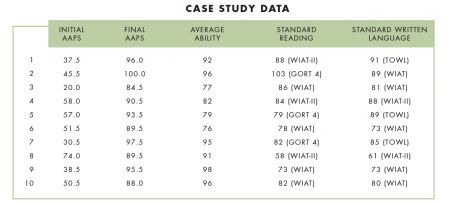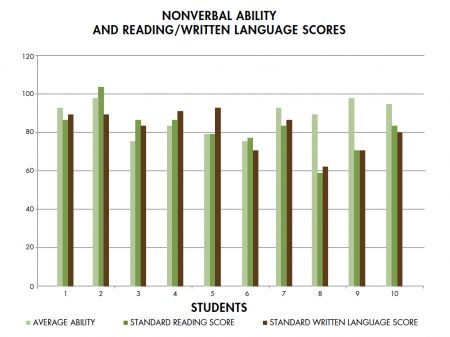DuBard School for Language Disorders
Research - Apraxia, Ability, Reading, Written Language
Page Content
Name of Project: Childhood Apraxia of Speech (CAS), Nonverbal Ability, Reading, and Written Language
Population: Students diagnosed with CAS (n=10) enrolled in the DuBard School for Language Disorders at various times between 1990 and 2004
Service Delivery Model: Therapy was delivered by nationally-certified speech-language pathologists or nationally certified educators of the deaf through the DuBard School’s intensive full-time enrollment program.
Assessment Instruments:
Arizona Articulation Proficiency Scale (AAPS)
- Total score values range from 0 to 100.
- Standard scores have a mean of 100 and a standard deviation of 15.
Hiskey-Nebraska Test of Learning Aptitude (H-NTLA)
- Standard scores have a mean of 100 and a standard deviation of 15.
Gray Oral Reading Test – Fourth Edition (GORT-4)
- Standard scores have a mean of 100 and a standard deviation of 15.
Wechsler Individual Achievement Test (WIAT)
- Standard scores have a mean of 100 and a standard deviation of 15.
Wechsler Individual Achievement Test – Second Edition (WIAT-II)
- Standard scores have a mean of 100 and a standard deviation of 15.
Length of time between pre- and post-test of articulation: Average of three years, one month. Range: one year, five months to five years, eight months.
Statistical Analyses: Paired sample t-tests, ANOVA
Results:
A significant increase in AAPS Total Scores was noted for students diagnosed with CAS and enrolled full-time in the DuBard School for Language Disorders, t(9) = -8.81, p < 0.001.
| AAPS Total Scores | |
| Pre-test total score mean | 46.30 |
| Post-test total score mean | 92.45 |

No significant difference was found when comparing average nonverbal ability, reading, and written language, F(2,18) = 2.41, p = 0.119.
| Average Nonverbal Ability, Post-test Reading, and Post-test Written Language Standard Scores | |
| Nonverbal ability mean | 88.20 |
| Reading standard score mean | 81.30 |
| Written language standard score mean | 81.00 |


Interpretation:
Students enrolled full-time in the DuBard School for Language Disorders made significant progress in articulation skills. Severe speech problems are often expected to result in reading problems; however, when average scores for nonverbal ability, reading, and written language were compared, there was no statistically significant difference in scores. For these students with severe articulation problems, reading and written language scores were commensurate with nonverbal ability.
References:
Fudala, J. B. (2000). Arizona Proficiency Scale: Third Revision. Los Angeles: Western Psychological Services.
Hiskey, M.S. (1966). Hiskey-Nebraska Test of Learning Aptitude. Lincoln, NE: Union College Press.
The Psychological Corporation. (1992). Wechsler Individual Achievement Test. San Antonio, TX: The Psychological Corporation
The Psychological Corporation. (2002). Wechsler Individual Achievement Test - Second Edition. San Antonio, TX: The Psychological Corporation
Wiederholt, J.L., and Bryant, B.R. (2001). Gray-Oral Reading Tests - Fourth Edition. Austin, TX: Pro-Ed, Inc.